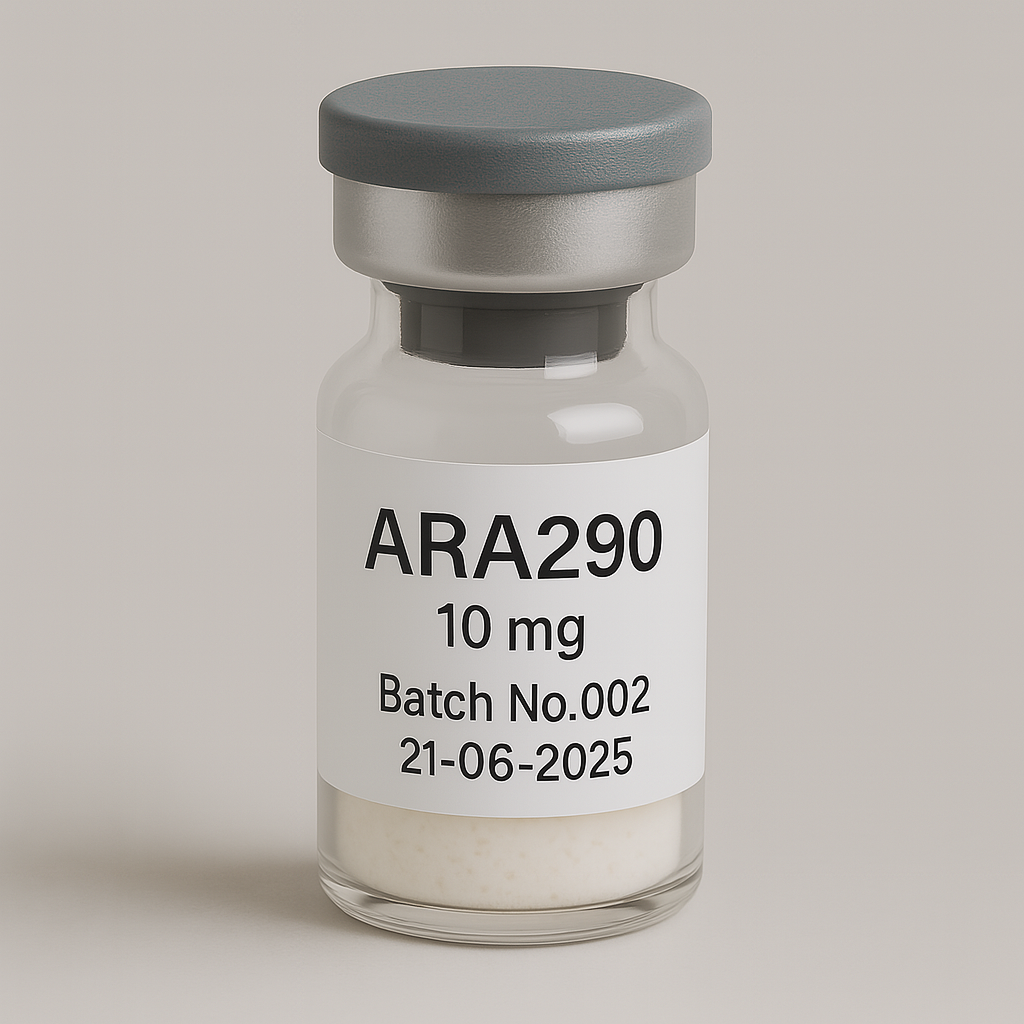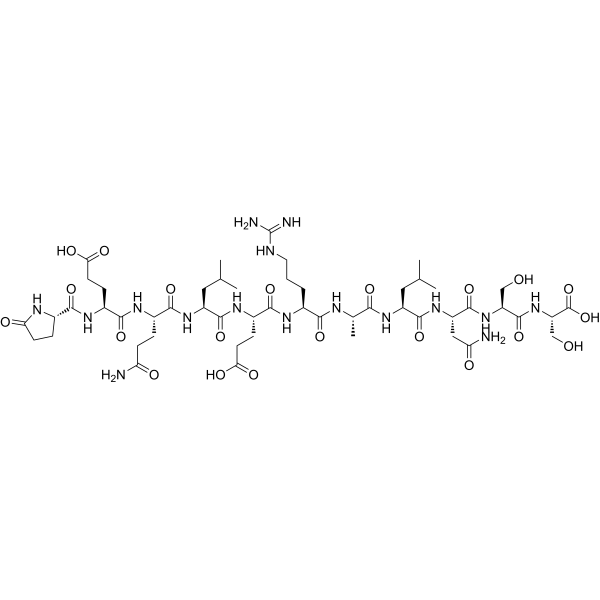
ARA290 10mg vial
Pickup currently not available
NOT FOR HUMAN CONSUMPTION
ARA 290, also known as Cibinetide, is an 11-amino acid synthetic peptide derived from the B-helix of erythropoietin (EPO). Engineered to selectively activate the Innate Repair Receptor (IRR)—a heteromeric complex of the EPO receptor (EPOR) and β-common receptor (CD131)—ARA 290 aims to harness EPO's tissue-protective and anti-inflammatory properties without stimulating erythropoiesis. This selective mechanism positions ARA 290 as a promising therapeutic candidate for conditions characterized by inflammation and tissue injury, such as small fiber neuropathy (SFN), diabetic neuropathy, and sarcoidosis-associated neuropathy.
2. Mechanism of Action
ARA 290's therapeutic effects are mediated through its selective binding to the IRR, which is upregulated in response to tissue injury and inflammation. Activation of the IRR initiates a cascade of cytoprotective and anti-inflammatory signaling pathways, leading to:
-
Suppression of pro-inflammatory cytokines: Reducing levels of TNF-α, IL-6, and other inflammatory mediators.
-
Inhibition of the NLRP3 inflammasome: Attenuating inflammasome activation, which plays a role in various inflammatory diseases.
-
Promotion of tissue repair: Enhancing angiogenesis, neurogenesis, and cellular survival mechanisms.
-
Regeneration of small nerve fibers: Stimulating the regrowth of damaged unmyelinated and thinly myelinated nerve fibers, crucial in conditions like SFN.
Importantly, ARA 290 does not engage the homodimeric EPOR responsible for erythropoiesis, thereby avoiding hematopoietic side effects associated with EPO therapy.
3. Clinical Efficacy
3.1. Small Fiber Neuropathy (SFN) and Sarcoidosis
In a randomized, placebo-controlled trial involving patients with sarcoidosis-associated SFN, subcutaneous administration of ARA 290 (4 mg daily for 28 days) resulted in:
-
Significant improvement in neuropathic symptoms: Measured by the Small Fiber Neuropathy Screening List (SFNSL) and PainDetect questionnaires.
-
Increased corneal nerve fiber density (CNFD): Assessed via corneal confocal microscopy, indicating nerve regeneration.
-
Enhanced quality of life: Improvements noted in the RAND-36 health survey.
These benefits persisted beyond the treatment period, suggesting sustained neuroprotective effects.
3.2. Diabetic Neuropathy
A Phase 2 clinical trial evaluated ARA 290 in patients with type 2 diabetes and painful neuropathy. Key findings included:
-
Improved glycemic control: Reduction in HbA1c levels maintained during a 56-day observation period.
-
Lipid profile enhancement: Favorable changes in cholesterol/HDL ratio and triglyceride levels.
-
Alleviation of neuropathic pain: Significant reductions in PainDetect scores.
-
Nerve fiber regeneration: Increased CNFD in patients with baseline deficits.
3.3. Other Therapeutic Areas
Preclinical studies have demonstrated ARA 290's potential in:
-
Renal ischemia/reperfusion injury: Enhancing glomerular filtration rate and reducing tubular damage.
-
Myocardial infarction and heart failure: Attenuating cardiac remodeling and improving function.
-
Burns and traumatic brain injury: Promoting tissue repair and reducing inflammation.
-
Depression: Ameliorating depression-like behaviors in animal models through anti-inflammatory mechanisms.
4. Safety and Tolerability
ARA 290 has exhibited a favorable safety profile:
-
Non-hematopoietic: No significant changes in hemoglobin or hematocrit levels.
-
Well-tolerated: Absence of serious adverse events in clinical trials.
-
Short half-life: Approximately 20 minutes, yet elicits prolonged therapeutic effects due to IRR activation.
5. Pharmacokinetics
-
Administration: Subcutaneous injection.
-
Bioavailability: Rapid absorption with peak plasma concentrations (~3 ng/mL) achieved post-injection.
-
Duration of action: Despite a short plasma half-life, the downstream effects of IRR activation confer sustained benefits.
6. Regulatory Status and Future Directions
While ARA 290 has shown promise in early-phase clinical trials, it has not yet received regulatory approval for clinical use. Ongoing research aims to further elucidate its therapeutic potential across various indications, including:
-
Chronic inflammatory diseases: Exploring efficacy in conditions like multiple sclerosis and inflammatory bowel disease.
-
Ophthalmic disorders: Investigating benefits in diabetic retinopathy and macular edema.
-
Autoimmune neuropathies: Assessing effects in conditions such as Guillain-Barré syndrome.
Continued clinical development and larger-scale trials are necessary to validate these applications and facilitate potential regulatory approval.
7. Conclusion
ARA 290 represents a novel class of therapeutic agents that selectively activate tissue-protective pathways without eliciting erythropoietic effects. Its ability to modulate inflammation, promote tissue repair, and regenerate nerve fibers positions it as a promising candidate for treating a range of conditions characterized by inflammation and tissue injury. Further clinical studies will be pivotal in determining its place in future therapeutic regimens.
References:
-
Brines, M., et al. (2015). ARA 290, a nonerythropoietic peptide engineered from erythropoietin, improves metabolic control and neuropathic symptoms in patients with type 2 diabetes. Molecular Medicine, 20(1), 658–666.
-
Heij, L., et al. (2012). Safety and efficacy of ARA 290 in sarcoidosis patients with symptoms of small fiber neuropathy: a randomized, double-blind pilot study. Molecular Medicine, 18(1), 1430–1436.
-
Ottens, P., et al. (2013). ARA290, a non-erythropoietic EPO derivative, attenuates renal ischemia/reperfusion injury. Journal of Translational Medicine, 11(1), 1–10.
-
Xu, G., et al. (2022). Nonerythropoietic erythropoietin mimetic peptide ARA290 ameliorates chronic stress-induced depression-like behavior and inflammation in mice. Frontiers in Pharmacology, 13, 896601.


